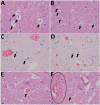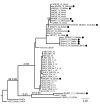Shuni Virus in Wildlife and Nonequine Domestic Animals, South Africa
- PMID: 32568048
- PMCID: PMC7323521
- DOI: 10.3201/eid2607.190770
Shuni Virus in Wildlife and Nonequine Domestic Animals, South Africa
Abstract
We screened nonequine animals with unexplained neurologic signs or death in South Africa during 2010-2018 for Shuni virus (SHUV). SHUV was detected in 3.3% of wildlife, 1.1% of domestic, and 2.0% of avian species. Seropositivity was also demonstrated in wildlife. These results suggest a range of possible SHUV hosts in Africa.
Keywords: Domestic animals; RT-PCR; Shuni virus; South Africa; neurological disease; orthobunyavirus; viruses; wildlife.
Figures


References
Publication types
MeSH terms
Supplementary concepts
Grants and funding
LinkOut - more resources
Full Text Sources

